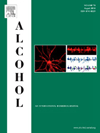
ALCOHOL
ALCOHOL
期刊介绍
Alcohol is an international, peer-reviewed journal that is devoted to publishing multi-disciplinary biomedical research on all aspects of the actions or effects of alcohol on the nervous system or on other organ systems. Emphasis is given to studies into the causes and consequences of alcohol abuse and alcoholism, and biomedical aspects of diagnosis, etiology, treatment or prevention of alcohol-related health effects.Intended for both research scientists and practicing clinicians, the journal publishes original research on the neurobiological, neurobehavioral, and pathophysiological processes associated with alcohol drinking, alcohol abuse, alcohol-seeking behavior, tolerance, dependence, withdrawal, protracted abstinence, and relapse. In addition, the journal reports studies on the effects alcohol on brain mechanisms of neuroplasticity over the life span, biological factors associated with adolescent alcohol abuse, pharmacotherapeutic strategies in the treatment of alcoholism, biological and biochemical markers of alcohol abuse and alcoholism, pathological effects of uncontrolled drinking, biomedical and molecular factors in the effects on liver, immune system, and other organ systems, and biomedical aspects of fetal alcohol spectrum disorder including mechanisms of damage, diagnosis and early detection, treatment, and prevention. Articles are published from all levels of biomedical inquiry, including the following: molecular and cellular studies of alcohol's actions in vitro and in vivo; animal model studies of genetic, pharmacological, behavioral, developmental or pathophysiological aspects of alcohol; human studies of genetic, behavioral, cognitive, neuroimaging, or pathological aspects of alcohol drinking; clinical studies of diagnosis (including dual diagnosis), treatment, prevention, and epidemiology. The journal will publish 9 issues per year; the accepted abbreviation for Alcohol for bibliographic citation is Alcohol.
酒精是一个国际性的同行评审期刊,致力于发表关于酒精对神经系统或其他器官系统的作用或影响的各个方面的多学科生物医学研究。该杂志的重点是研究酒精滥用和酒精中毒的原因和后果,以及酒精相关健康影响的诊断、病因学、治疗或预防的生物医学方面。该杂志面向研究科学家和临床医生,发表与饮酒、酒精滥用、寻求酒精的行为、耐受性、依赖、戒断、长期禁欲和复发。此外,该杂志还报道了关于酒精对一生中神经可塑性的大脑机制的影响,与青少年酗酒有关的生物因素,治疗酒精中毒的药物治疗策略,酗酒和酒精中毒的生物和生化标记,不受控制的饮酒的病理影响,对肝脏,免疫系统和其他器官系统影响的生物医学和分子因素,以及胎儿酒精谱系障碍的生物医学方面,包括损伤机制、诊断和早期检测、治疗和预防。发表的文章来自各级生物医学调查,包括:酒精在体外和体内作用的分子和细胞研究;酒精的遗传学、药理学、行为学、发育学或病理生理学方面的动物模型研究;对饮酒的遗传、行为、认知、神经成像或病理方面的人类研究;诊断(包括双重诊断)、治疗、预防和流行病学的临床研究。该杂志每年出版9期;文献引用中酒精的公认缩写是Alcohol。
| 年发文量 | 74 |
| 国人发稿量 | 2 |
| 国人发文占比 | 2.7% |
| 自引率 | 4.0% |
| 平均录取率 | 较易 |
| 平均审稿周期 | 较慢,6-12周平均15.6周 |
| 版面费 | US$2880 |
| 偏重研究方向 | 医学-毒理学 |
| 期刊官网 | http://www.elsevier.com/wps/find/journaldescription.cws_home/525453/description#description |
| 投稿链接 | https://www.editorialmanager.com/ALCOHOL |
质量指标占比
| 研究类文章占比 | OA被引用占比 | 撤稿占比 | 出版后修正文章占比 |
|---|---|---|---|
| 98.61% | 29.73% | 0.00% | 0.91% |
相关指数
期刊预警不是论文评价,更不是否定预警期刊发表的每项成果。《国际期刊预警名单(试行)》旨在提醒科研人员审慎选择成果发表平台、提示出版机构强化期刊质量管理。
预警期刊的识别采用定性与定量相结合的方法。通过专家咨询确立分析维度及评价指标,而后基于指标客观数据产生具体名单。
具体而言,就是通过综合评判期刊载文量、作者国际化程度、拒稿率、论文处理费(APC)、期刊超越指数、自引率、撤稿信息等,找出那些具备风险特征、具有潜在质量问题的学术期刊。最后,依据各刊数据差异,将预警级别分为高、中、低三档,风险指数依次减弱。
《国际期刊预警名单(试行)》确定原则是客观、审慎、开放。期刊分区表团队期待与科研界、学术出版机构一起,夯实科学精神,打造气正风清的学术诚信环境!真诚欢迎各界就预警名单的分析维度、使用方案、值得关切的期刊等提出建议!
预警情况
查看说明
| 时间 | 预警情况 |
|---|---|
| 2024年02月发布的2024版 | 不在预警名单中 |
| 2023年01月发布的2023版 | 不在预警名单中 |
| 2021年12月发布的2021版 | 不在预警名单中 |
| 2020年12月发布的2020版 | 不在预警名单中 |
JCR分区 WOS分区等级:Q2区
| 版本 | 按学科 | 分区 |
|---|---|---|
|
WOS期刊SCI分区
WOS期刊SCI分区是指SCI官方(Web of Science)为每个学科内的期刊按照IF数值排
序,将期刊按照四等分的方法划分的Q1-Q4等级,Q1代表质量最高,即常说的1区期刊。
(2021-2022年最新版)
|
||
| TOXICOLOGY | Q3 | |
| SUBSTANCE ABUSE | Q2 | |
| PHARMACOLOGY & PHARMACY | Q3 |
关于2019年中科院分区升级版(试行)
分区表升级版(试行)旨在解决期刊学科体系划分与学科发展以及融合趋势的不相容问题。由于学科交叉在当代科研活动的趋势愈发显著,学科体系构建容易引发争议。为了打破学科体系给期刊评价带来的桎梏,“升级版方案”首先构建了论文层级的主题体系,然后分别计算每篇论文在所属主题的影响力,最后汇总各期刊每篇论文分值,得到“期刊超越指数”,作为分区依据。
分区表升级版(试行)的优势:一是论文层级的主题体系既能体现学科交叉特点,又可以精准揭示期刊载文的多学科性;二是采用“期刊超越指数”替代影响因子指标,解决了影响因子数学性质缺陷对评价结果的干扰。整体而言,分区表升级版(试行)突破了期刊评价中学科体系构建、评价指标选择等瓶颈问题,能够更为全面地揭示学术期刊的影响力,为科研评价“去四唯”提供解决思路。相关研究成果经过国际同行的认可,已经发表在科学计量学领域国际重要期刊。
《2019年中国科学院文献情报中心期刊分区表升级版(试行)》首次将社会科学引文数据库(SSCI)期刊纳入到分区评估中。升级版分区表(试行)设置了包括自然科学和社会科学在内的18个大类学科。基础版和升级版(试行)将过渡共存三年时间,推测在此期间各大高校和科研院所仍可能会以基础版为考核参考标准。 提示:中科院分区官方微信公众号“fenqubiao”仅提供基础版数据查询,暂无升级版数据,请注意区分。
中科院分区
查看说明
| 版本 | 大类学科 | 小类学科 | Top期刊 | 综述期刊 |
|---|---|---|---|---|
|
医学
4区
|
TOXICOLOGY
毒理学
3区
SUBSTANCE ABUSE
药物滥用
4区
PHARMACOLOGY & PHARMACY
药学
4区
|
否 | 否 | |
|
2021年12月
基础版
|
医学
4区
|
TOXICOLOGY
毒理学
4区
SUBSTANCE ABUSE
药物滥用
4区
PHARMACOLOGY & PHARMACY
药学
4区
|
否 | 否 |
|
2021年12月
升级版
|
医学
4区
|
TOXICOLOGY
毒理学
4区
SUBSTANCE ABUSE
药物滥用
4区
PHARMACOLOGY & PHARMACY
药学
4区
|
否 | 否 |
|
2020年12月
旧的升级版
|
医学
4区
|
TOXICOLOGY
毒理学
4区
SUBSTANCE ABUSE
药物滥用
4区
PHARMACOLOGY & PHARMACY
药学
4区
|
否 | 否 |
|
2022年12月
最新升级版
|
医学
4区
|
TOXICOLOGY
毒理学
4区
SUBSTANCE ABUSE
药物滥用
4区
PHARMACOLOGY & PHARMACY
药学
4区
|
否 | 否 |












